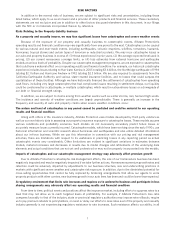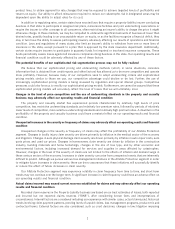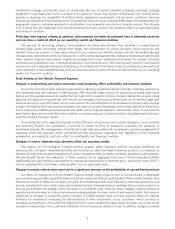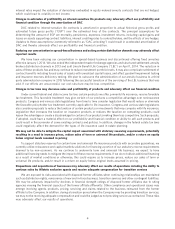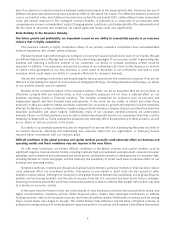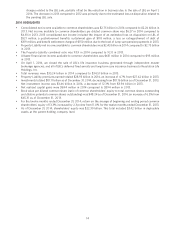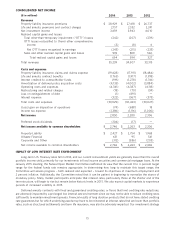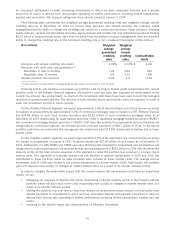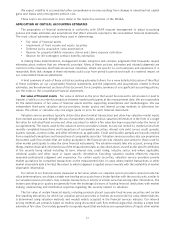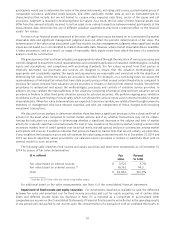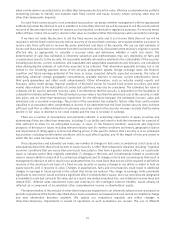Allstate 2014 Annual Report Download - page 110
Download and view the complete annual report
Please find page 110 of the 2014 Allstate annual report below. You can navigate through the pages in the report by either clicking on the pages listed below, or by using the keyword search tool below to find specific information within the annual report.The realization of deferred tax assets is subject to uncertainty
The realization of our deferred tax assets, net of valuation allowance, if any, is based on our assumption that we will
be able to fully utilize the deductions that are ultimately recognized for tax purposes. However, actual results may differ
from our assumptions if adequate levels of taxable income are not attained.
The ability of our subsidiaries to pay dividends may affect our liquidity and ability to meet our obligations
The Allstate Corporation is a holding company with no significant operations. The principal asset is the stock of its
subsidiaries. State insurance regulatory authorities limit the payment of dividends by insurance subsidiaries, as
described in Note 16 of the consolidated financial statements. The limitations are based on statutory income and
surplus. In addition, competitive pressures generally require the subsidiaries to maintain insurance financial strength
ratings. These restrictions and other regulatory requirements affect the ability of the subsidiaries to make dividend
payments. Limits on the ability of the subsidiaries to pay dividends could adversely affect holding company liquidity,
including our ability to pay dividends to shareholders, service our debt, or complete share repurchase programs in the
timeframe expected.
Management views enterprise economic capital as a combination of statutory surplus and invested assets at the
parent holding company level. Deterioration in statutory surplus or earnings, from developments such as catastrophe
losses, or changes in market conditions or interest rates, could adversely affect holding company liquidity by impacting
the amount of dividends from our subsidiaries or the utilization of invested assets at the holding company to increase
statutory surplus or for other corporate purposes.
Our ability to pay dividends or repurchase our stock is subject to limitations under terms of certain of our securities
Subject to certain limited exceptions, during any dividend period while our preferred stock is outstanding, unless the
full preferred stock dividends for the preceding dividend period have been declared and paid or declared and a sum
sufficient for the payment thereof has been set aside and any declared but unpaid preferred stock dividends for any prior
period have been paid, we may not repurchase or pay dividends on our common stock. If and when dividends on our
preferred stock have not been declared and paid in full for at least six quarterly dividend periods, the authorized number
of directors then constituting our board of directors will be increased by two additional directors, to be elected by the
holders of our preferred stock together with the holders of all other affected classes and series of voting parity stock,
voting as a single class, subject to certain conditions.
We are prohibited from declaring or paying dividends on our preferred stock if we fail to meet specified capital
adequacy, net income or shareholders’ equity levels. The prohibition is subject to an exception permitting us to declare
dividends out of the net proceeds of common stock issued by us during the 90 days prior to the date of declaration even
if we fail to meet such levels.
The terms of our outstanding subordinated debentures also prohibit us from declaring or paying any dividends or
distributions on our common or preferred stock or redeeming, purchasing, acquiring, or making liquidation payments on
our common stock or preferred stock if we have elected to defer interest payments on the subordinated debentures,
subject to certain limited exceptions.
Changing climate conditions may adversely affect our financial condition, profitability or cash flows
Climate change, to the extent it produces changes in weather patterns, could affect the frequency or severity of
weather events and wildfires, the affordability and availability of homeowners insurance, and the results for our Allstate
Protection segment.
Loss of key vendor relationships or failure of a vendor to protect our data or personal information of our customers,
claimants or employees could affect our operations
We rely on services and products provided by many vendors in the United States and abroad. These include, for
example, vendors of computer hardware and software and vendors of services such as claim adjustment services,
human resource benefits management services and investment management services. In the event that one or more of
our vendors suffers a bankruptcy or otherwise becomes unable to continue to provide products or services, or fails to
protect our data or personal information of our customers, claimants or employees, we may suffer operational
impairments and financial losses.
We may not be able to protect our intellectual property and may be subject to infringement claims
We rely on a combination of contractual rights and copyright, trademark, patent and trade secret laws to establish
and protect our intellectual property. Although we use a broad range of measures to protect our intellectual property
10



